
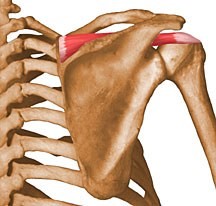
Therapist Blog by Jim Norris (PT, DPT)
The supraspinatus is one of the four rotator cuff muscles surrounding the shoulder. Each of the rotator cuff muscles play an important role in maintaining stability in the glenohumeral (GH) joint. They also play a key role in controlling the direction, degree, and quality of motion of the humeral head during upper extremity movements, which is required for optimal shoulder function to occur. The supraspinatus is arguably the most important rotator cuff muscle for providing dynamic stability of the humeral head during overhead activities.1
*Note: The humerus is the bone that articulates with the glenoid fossa of scapula and gives rise to the shoulder joint, hence glenohumeral joint.
The supraspinatus originates in the supraspinous fossa (a shallow depression at the top of the scapula), and attaches on the greater tubercle (a bony landmark) of the head of the humerus. The supraspinatus muscle compresses, abducts, and generates a small external rotation torque on the glenohumeral joint.2 Due to the line of pull of the supraspinatus during abduction, the supraspinatus is a more effective shoulder abductor in scapular plane at lower abduction angles compared to the deltoid, which is a more effective shoulder abductor at higher abduction angles (as the arm is raised higher overhead).3 Specifically, supraspinatus activity reaches its peak torque between 30 and 60 degrees of abduction. For reference, raising your arm to the side so that it is in line with your shoulder horizontally is considered 90 degrees. Also, the supraspinatus initiates glenohumeral flexion and abduction beginning in neutral position (arm by side at 0 degrees).
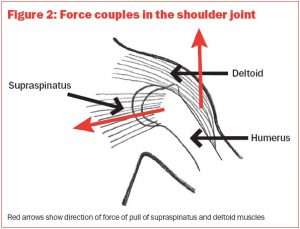
The key role the supraspinatus plays is to provide additional humeral head compression within the glenoid fossa to counter the humeral head superior translation (rising up) occurring with contraction of the deltoid. This is very important in providing dynamic glenohumeral stability by centering the humeral head within the glenoid fossa during all upper extremity functional movements. Without the supraspinatus providing this compressive force, shoulder complications are likely to result.
How is the Supraspinatus Injured?
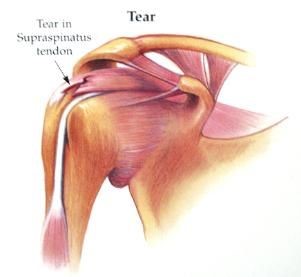
Weakness of the rotator cuffs, especially the supraspinatus, can lead to superior humeral head migration (humeral head slowly starts to slide up) that may be observed when the rotator cuff does not adequately compress the humerus within the glenoid fossa to counteract the superior pull of the deltoid. It is important to understand that the deltoid is the primary mover for lifting the arm overhead, especially when raising the arm up past shoulder height. So when the supraspinatus is not strong enough to hold the humeral head in place, the bone will continue migrating superiorly (in the direction the deltoid is pulling) and then run out of space. This can lead to other complications, including subacromial impingement and tendon degeneration from disuse. Another possible injury is tendinitis (or tendinopathy), or a tear of the tendon. These can be due to overuse (repeated overhead activities such as swimming, throwing, or tennis) over a period of time, or an acute injury. An acute injury can be caused by a fall, direct blow, or a rapid use of force. It is also worth noting that the supraspinatus is the most often injured rotator cuff muscle. The inability to smoothly abduct arm against resistance may indicate rotator cuff injury.
*Note: The subacromial area is the space between the humeral head and the acromion, which is a bony landmark of the scapula that is located at the top of the shoulder.
How to protect yourself from injury
The best way to avoid any of these injuries starts with good body mechanics and posture. The best position for optimal supraspinatus function is keeping the shoulders retracted (squeezing shoulder blades together). Not only does this give the supraspinatus muscle a biomechanical advantage, but it also puts the scapula in the most ideal position to allow free overhead arm movement. Unfortunately, many individuals have a more protracted (rounded forward) shoulder position, and a common contributing factor to this malposition is sitting for prolonged periods of time. This is important to prevent because scapular protraction has been shown to decrease the amount of subacromial space the humerus has to move in, which increases the risk of subacromial impingement. In contrast, shoulder retraction has been shown to increase the subacromial space, while also increasing the supraspinatus strength potential. This also prevents weakness of the supraspinatus muscle from developing, as a more protracted position would rely more on the deltoid muscle to get the arm overhead.
Exercises to prevent/rehabilitate
There are several different exercises commonly used to strengthen the supraspinatus. Research has suggested the “full can position” or elevation in the scapular plane with glenohumeral external rotation (thumb facing up) is the most effective at targeting supraspinatus. This position was found to both strengthen the supraspinatus effectively while also minimizing activity of the deltoid.2
1. Full Can Raise (In Scapular Plane)
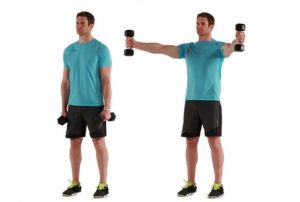
- Recommend to use light or no weight
- In standing position, start with arms by side, shoulders retracted, and palms forward
- Maintain shoulder retraction and hand position, raise arms up into the air in the scaption plane (about 30-45 degrees in front of the side of your body)
- Stop once at shoulder level, and slowly lower back down
- 2-3 sets of 10-15 repetitions
*It is also important to note that performing this exercise with thumbs down (internal rotation) promotes a protracted scapula, which decreases the amount of space in the subacromial area. Therefore, it is important to make sure palms face forward and thumbs up towards the ceiling to allow more room for the humerus to move.2
2. Prone Full Can Raise
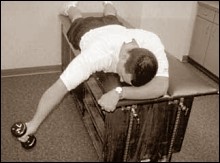
- Recommend light or no weight
- Lay flat on your stomach (best if performed on bench)
- Start with arms down towards the ground, slightly in front of the shoulders (about 10 degrees), as opposed to directly under the shoulders
- Palms should be facing forward
- Raise arms directly to the side from starting position until about shoulder height, then slowly lower
- 2-3 sets of 10-15 reps
The next exercise is useful for isolating the supraspinatus without putting stress on surrounding tissue around the shoulder. This can be beneficial when recovering from injury that may or may not involve the supraspinatus itself.
3. Supraspinatus Isometrics
- Start with arm by your side, elbow flexed to 90 degrees, and with the working side next to a wall.
- Place a towel between the arm and the wall for comfort
- Push the arm (leading with elbow) into the wall, as if you would be raising the forearm up in the air if the wall was not there.
- Hold for about 6-8 seconds, repeat 10 times.
*This can also be down a little farther from the wall to work higher abduction angles (can use wall until about 30- 45 degrees)
4. T-band Rows
- Wrap a band around a pole or any immovable object at belly button height.
- Hold on to both ends of the band so that there is equal length on each side, while also keeping tension in the band at the starting position
- Begin with elbows extended with an upright trunk (maintained throughout), and then pull elbows straight back, keeping the elbows tucked in
- Pinch the shoulders while pulling the band back (imagine trying to squeeze a dollar bill between each shoulder blade)
- 2-3 sets of 10-15 repetitions
References
- http://digitalrepository.unm.edu/cgi/viewcontent.cgi?article=1023&context=dpt
- Reinold MM, Escamilla R, Wilk KE. Current Concepts in the Scientific and Clinical Rationale Behind Exercises for Glenohumeral and Scapulothoracic Musculature. Journal of Orthopaedic & Sports Physical Therapy. 2009;39(2):105-117. doi:10.2519/jospt.2009.2835.
- http://www.exrx.net/Muscles/Supraspinatus.html
- https://www.uptodate.com/contents/rotator-cuff-tendinitis-and-tear-beyond-the-basics
